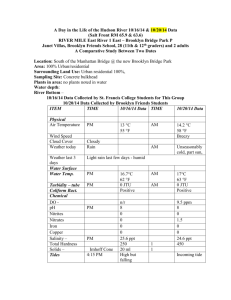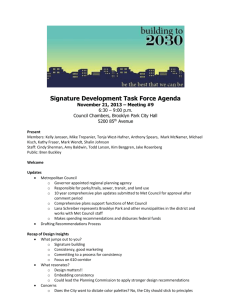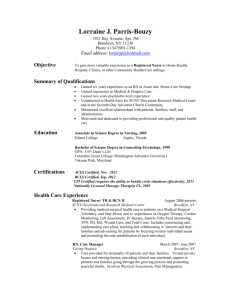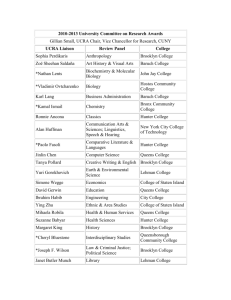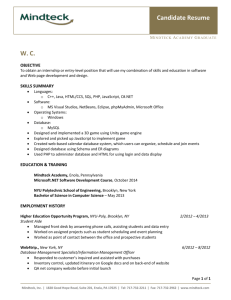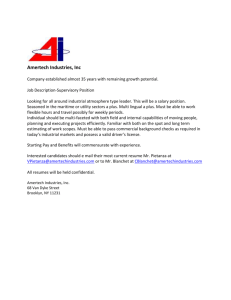unCOMMON GROUND ARCHIVES LIBRARIES FEB
advertisement
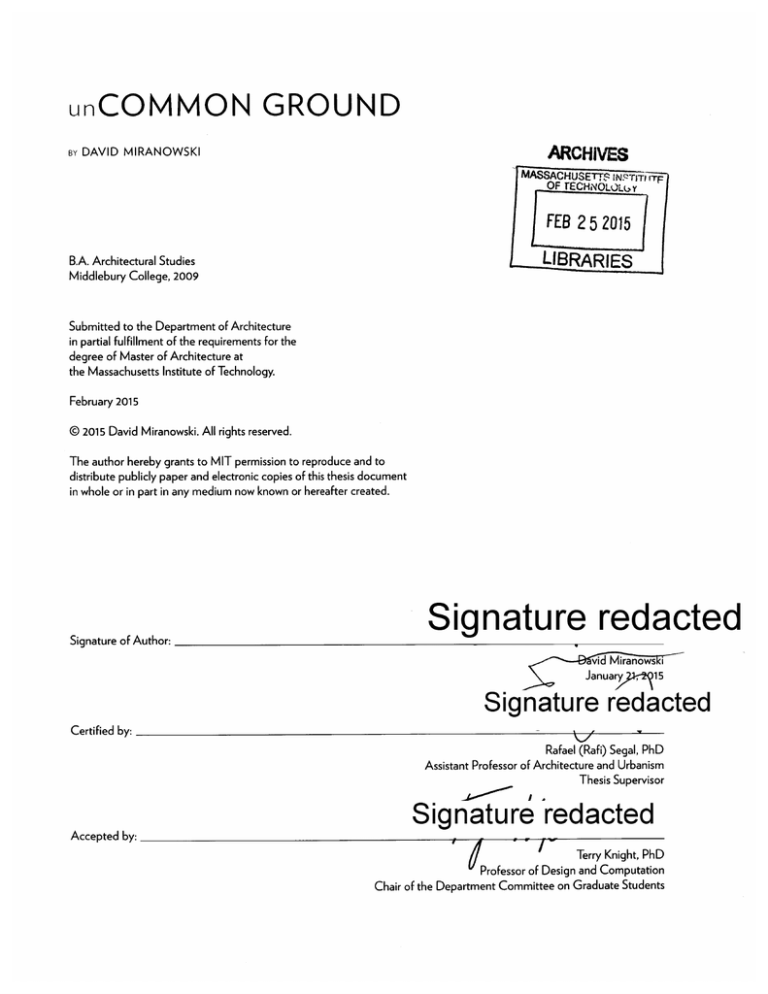
unCOMMON GROUND
BY
ARCHIVES
DAVID MIRANOWSKI
MASSACHUSETTS INSTJ
OF rECHNOL0L y
iTF
FEB 252015
LIBRARIES
B.A. Architectural Studies
Middlebury College, 2009
Submitted to the Department of Architecture
in partial fulfillment of the requirements for the
degree of Master of Architecture at
the Massachusetts Institute of Technology.
February 2015
@ 2015 David Miranowski. All rights reserved.
The author hereby grants to MIT permission to reproduce and to
distribute publicly paper and electronic copies of this thesis document
in whole or in part in any medium now known or hereafter created.
Signature redacted
Signature of Author:
vid Miranows
Janua>225
Signature redacted
Certified by:
Rafael (Rafi) Segal, PhD
Assistant Professor of Architecture and Urbanism
Thesis Supervisor
Signature redacted
Accepted by:
A cce ted by:
W. / - Te r ry K n igh t , Ph D
Professor of Design and Computation
Chair of the Department Committee on Graduate Students
COMMITTEE
Rafi Segal, PhD
Associate Professor of Architecture and Urbanism
Ana Miljacki, MArch, PhD
Associate Professor of Architecture
William O'Brien, Jr., MArch
Associate Professor of Architecture
unCOMMON GROUND
BY
DAVID MIRANOWSKI
Thesis Supervisor: Rafi Segal, PhD
Title: Associate Professor of Architecture and Urbanism
ABSTRACT
Brooklyn's urban fabric is a redundant array of perimeter
residential blocks, built out over the last 200 years as a layered
accretion. Within each block is a core that is spatially unified
yet distinct from the public front of the street. These spaces
are defined by their enclosure yet this barrier is not entirely
impenetrable. Each block possesses a few unique moments
of slippage in which the perimeter mass opens up to reveal a
slivered view into the depths, and potentials, of this internalized
world.
To the vast majority, including residents, these slivers and cores
remain a visual phenomenon. The near-universal practice of
extruding backyard parcel lines has created an architecture of
division, namely the fence, closing off the yard from the block
and the block from the neighborhood. This thesis proposes an
alternative scenario, in which rear fences are removed and a thin
line of public space is inserted into the mosaic of existing yards.
The line, activated through a set of calibrated relationships
with the ground and floating infrastructure, stitches together
people within the open core and works against the detritus of
old divisions. Through this intervention, a new grain emerges
which connects Brooklyn's blocks and transforms the residual
slivers into a network of spaces that open to an engaging, and
unexpected, rendering of the pre-existing.
Submitted to the Department of Architecture on
June 20, 2015 in partial fulfillment of the requirements
for the degree of Master of Architecture.
3
~1
ACKNOWLEDGEMENTS
Rafi, thank you for sharing your wisdom and for continually pushing
me beyond my comforts. Your thoughtfulness and intellect led me to
unexpected findings, and for that I am very grateful.
Liam, it was a great pleasure to work with you during my time at MIT.
Being immersed in your methodologies has shaped who I am as a
designer. Thank you for all your insight and dedication.
Ana, a sincere thanks for challenging me this semester. The project
became much stronger through your poignant critique.
Austin, Aurimas, Enas, Kyle, Kyung Sik, and Liz, your generosity is
truly unparalleled. Thank you for being so amazingly helpful as I pushed
to finish this project.
Bates crew, thanks for the continued support and for bringing the fun!
Susan and Mike, thanks for always being there for me. I love you guys.
Mom and Dad, it is impossible to thank you two enough. You have
always encouraged me to pursue my passions and my curiosities to the
fullest. Thank you so much for guiding me without steering and for
making this all possible. To me it is the greatest gift and it has brought
so much joy to my life. Thank you from the bottom of my heart.
Mary Kate, your love and patience through this journey have been a
true blessing. Thank you simply for being you. Now, on to some new
adventures!
common
groun
LDavi
i
nw~
z
0
an urban evolution
U
0
site: Brooklyn, New York
Z-
population : 2.6 mil
first settled: 1634
BROOKLYN PETRI
urban
Cn evolution
Brooklyn's urban fabric reveals a narrative of rapid growth and transformation.
It was less than 200 years ago when this land was wide-open, playing host to a handful of
Dutch farmers who used the soil to grow wheat, oats, barley, and corn. Up until the late
19th century, when farmers had shifted their primary crops towards fruits and vegetables,
Brooklyn -and the greater King's County -was the second-largest provider of produce in
the country.t Roll the clock forward 100 years, to the end of the 20th century, and you will
see a radically different Brooklyn, no longer second
second-nationally in population density.
in agricultural production, but rather
To stimulate this urban transformation, developers divided and rationalized Brooklyn's
land across several scales - infrastructural, neighborhood, block, and private lot. Through
the capitalist logic of parcelization, the ground was primed for a new density of residential
building stock and, in turn, gained significant value as a financial commodity. What began
as the incremental sale of a few farms near Brooklyn's original urban center quickly grew to
become an all-encompassing speculative grid, draped across the entire borough. By midto late 19th century, the comprehensive framework for Brooklyn's future neighborhoods
had been almost fully established, both as an abstraction and through physical infrastructure. Though at times rapid to the point of being reckless, the pixelated aggregation of
individual units within these grids would ensue for the next 150+ years.
'0
iD
ix
59
1855
100
9
2
201
I
N
. ''TOWN O0BOO.P
ti N aI o'
0
LOXTvd.orISEAN
.4
I
6
si::
6
II
6.
r
\~\
r)
6
\)
/
II
~1~
/
;
h
I
133
I
...................................--..--
K.
~fit~i? r;f;'')fK,'
K
~t
0061
(0R
...........
.
. ..
. .....
........
.......
-- -- ..........
......
. ......
...
............
2I74m;i/l
Imil
BROOKLYN POPULATION vs. TIME
13
A SERIES OF DIVISIONS,
ACROSS SCALES
build
-
--
vut
nrhp 1965-1985
1830-1920
I;
CONSTRUCTING BROOKLYN'S
HISTORIC NEIGHBORHOODS
tIhIi oB-i7dl hI vEuon, 4eI'
15
"Remnants of past and
present lay atop one
another, the sediment
from each historic cityscape seeping into the
others."
00
16
I' ,''I
-A
IC - -O
F i RIDI')
>2
44
"With the borough's oldest street grid and an assortment of buildings dating back to
the colonial era," writes U.S. historian Suleiman Osman, "brownstone Brooklyn was
a tectonic cityscape with the architectural and social imprints of multiple economic
stages: a Dutch agricultural economy, a mercantile port city, an immigrant industrial
city, and an administrative office city."2 This layered evolution is manifest in Brooklyn's overlapping stree grids, which shift to accommodate previously established
thoroughfares, property boundaries, land-uses, and significant architecture. The
"multi-authored" history, as put by the urban theorist Eve Blau,
is "visibly registered in the physical fabric of the city."3
200,
And yet, despite this wealth of peculiarities, Brooklyn's urban fabric is surprisingly
redundant in its formal composition because it is stitched almost exclusively around
of the same typological unit: the perimeter residential block. Conceived of as a systematic way to produce residential density while still maintaining adequate exposure
to sun, air, and private open space, Brooklyn's perimeter block is structured around
two disproportionate axes: a long axis of about 750', which splits the block into two
rows of parcels, and a 200' short axis, which establishes the combined depth of two
abutting parcels.
"..peel back the accumulated spatiotemporal layers
of the built fabric to discover moments of alteration,
addition, erasure, misalignment and realignment."
" I
IQ77
" 1, '
I
L
"
) W j,
- r ()I ( , Z , I c 11
,
7
_ " j,/
IR
j~I
I'
-
I
Zh
w resulting space
SLIVERS AND CORES
While it was conceived largely around practical domestic concerns, paired with the
logistical desire for expansive and rapid deployment across the city, the perimeter
block presents some incredible spatial opportunities. In this scenario it is productive
to separate intention - the context out of which the block is invented - from outcome,
which I see as an abundant array of unique spaces that are each inscribed within an
aggregated mass. This is an essential exercise according to Blau, who asserts that
"the chronologically backward reading of the urban fabric constructs a narrative that
foregrounds action - what the intervention or object actually does - rather than
what it is intended or designed to do. It thereby reproduces the lived experience of
encounter with the built object... The reverse reading," she continues, "produces a
kind of knowledge that is spatial and fundamentally architectura."4 When viewing
Brooklyn through this lens - through a deliberately intuitive, spatial, and experiential
vantage - the perimeter block can be recognized as producing this magical set of
spaces - embedded within real urban density, and yet, totally separate. There is
something poetic about the way these spaces emerge through an accumulation of
discrete units over time. These urban interiors, which I refer to as "cores", are a focus
of this thesis.
(l
1]
. . ...............
cores
ii
Li
Ii
H
LI
11
I
Zl
w resulting spaces
Jr
SLIVERS AND CORES
"The space between the urban and the interior is one that continues to unfurl, requiring that one interrogates the productive
interplay at the threshold where it is not possible to say whether
one occupies a realm of privacy or publicity, a space on the inside
or outside, a collective or individual moment." '-
The core spaces are defined by their enclosure but this barrier is not entirely impenetrable. Each block possesses a few unique moments of slippage in which the
perimeter mass opens to reveal a slivered view into the depths of this internalized
world. It is through the "slivers" that the hidden core becomes tied to the public front
of the street. These are thresholds into a distinct space, nested deeply within the
city, centered, and yet so very proximate. A few thin voids within an otherwise solid
shell flickers light onto the sidewalk and provides a glimpse into the potentials of this
otherwise mundane urban morphology.
............
- .
...........
..
.........
.. .---
---
slivers"
*
I
Li
N
d
~r]
-
II
[1
1
-13
H
[7
H
HF
Ii
iii
I
[I
/
.............
.
..............
.........................
.............
.
....
.......
............
A
II
9)y R)icjo
LBack)i:yIds.
A
B
IA
i91
The core spaces emerge through an
aggregation of individual units over
time.
B
A
.
............
......
.
...
.........................
-111,111,111,11111-11,'ll""I'll""I'll",'ll""Ill""I'll""-"""'ll-
ooyl,- Dri I
FORT GREENE'S SLIVERS
cataloguing the residual
-
The word 'residual' is defined as, "a quantity remaining after other things have been subtracted."6 In the case of Brooklyn's slivers, the concept of the residual is actually inverted
it emerges through a process of addition, rather than subtraction, producing a void rather
than some remaining solid. As voids, the slivers are defined by the exterior walls of two
or more adjacent buildings. The scale of the slivers varies directly in proportion to the
spacing between the unrelated buildings and can range anywhere between 3 to 110 feet.
These gaps occur for several reasons, but are most-typically the product of codified
setback regulations, private passages to backyards, odd lots, and/or the varied geometric
conditions between parcels when the block shifts between its long and short face. The
following is a catalogue of the multi-scalar residual spaces found throughout the Fort
Greene neighborhood in Brooklyn. The catalogue is organized according to the width of
each sliver.
28
/
11
A
I
A
II
.3(
I
I
. .............
....................
....
..........
.........
.7'
1
LLWJ
~Th
pbvD
%A
31
i
3)
.
...
......
-
...
--- ---. ...........
.....
F
I'
tX2
Ua
--
M------- -
It
41
42
43
-
~~~~
~"
i ..
-ws
. .. *..
...%... = *:--wr . s
I
.. :
....
..
- -- mo m........4 ....
45
..
........
. ...
I6
..........
. ....
.:...:....:::
..
:-.......:::::..::.......................---.
.::::...-......::----...:-.-:.::....::............-:-..-.....::.::-.:-:::......-.-,,..-..------.--.---::.-.
---------.
;.-...--.-......:::-:-::.::::---...-;--.::-.----.----:-:---......-----.
, .......... ,.-,.....
z
inhabitation
ISOLATED, CONFINED, DIVIDED
To the vast majority, including to residents, these slivers and cores remain a visual phenomenon.
The near-universal practice of 6xtruding backyard parcel lines has created an architecture of
division, namely the fence, closing off the yard from the block and the block from the neighborhood.
Our co-isolated inhabition of this fabric is written into these divisions and produces enormous
redundancies. Neighbors are stacked on top of one another but, regardless of these proximities,
remain complete strangers. As mentioned before, Brooklyn is set within the second-most
densely populated county in the United States, but increased density does not translate to
increased connectivity. If anything, it fuels a divisive mindset that architecture needs to seal off
the hermetic individual from the threatening urban metropolis.
This thesis roots itself firmly in the belief that there is a connection between urban form and
communal engagement. We condition our environment, based on our fears, habits, and desires,
but our environment also, in turn, conditions us. This thesis seeks to undo some of the rigid and
wasteful divisions of space that are, by now, just a relic of the early parcel system. Architecture
can help to facilitate the mindset that collectivity demands.
.18
I-
I
I
'I()
FA
.
7)1
......
.......
*I*
4k4
W
k
fx*e
jj
Lk
terra
L
earth, land
terratorium
I
land within a boundary
terrain (piece of earth) + -orium (denotesplace)
territo y
ziniei-w
an area of land under the
jurisdiction of a ruler or state
BROOKLYN
BACKYARDS
-- --
-------
..
........
(oogle Image Results for "Brooklyn Backyard
[" i
Homo Ibn ) r k.,omI It?
........
..............
......
-------------
.
I:> (jail
E7a h/Yip
Our only connection to these people,
though frequent, is visual.
We are all strangers,
tucked behind panes of glass.
58
..'41
URBAN PROXIMITY/ISOLATION ANALYSIS,
CASE-STUDY: PERIMETER BLOCK WITHIN BOSTON'S BACK BAY
60
..
..
..
...
..
61
3-
1~
N
z
potentials
"cultural recycling": a process that involves
continuously reworking and editing, rather
than obliterating, what is there."7 Eve Blau
TRANSFORMATIVE POTENTIALS
a provocation
This thesis rejects our co-isolated inhabitation of the urban grid and explores the
potential of weaving in new layers that can transform the existing. How do we reprogram space and, more importantly, recondition what has become a stale mindset
for city living? Rather than fighting the atomization of the home, however, this thesis
seeks to rethink the notion of collectivity outside of it.
The fundamental provocation is to suggest that Brooklyn's blocks become centered
around shared open space. We don't need to start from scratch to change our living
habits. Rather, we can carve into existing built fabric, 200 years later, by knocking
down fences, and creating a landscape for a thriving new type of communal living.
(This urban form has already gone through several changes, after all!) Rear fences
are removed and a thin line of public space is inserted into the mosaic of existing
yards. Through this transformation, the slivers become occupiable in exciting new
ways and the shielded ground plane becomes a datum for new forms of social connectivity and engagement. The closed geometry of the neighborhood gets eroded
just enough for the urban dweller to grow accepting of the block as a nourishing
extension of their home. No longer confined to the thin shell of their apartment walls,
Brooklyn, too, becomes their home.
041
Oi7
66
.... .........
-
...........
-
67
.
......
..
...........
68
69
This thesis offers a glimpse into a more
collective architectural fabric - diversifying
the distinctions between interior/exterior,
public/private - in hopes of expanding the
notion of personal territory in our dense
cities through new formal arrangements and
minimal means.
70
tt
i-FA
M
a
*
.9
&
t
itI
f
it
U
drawings
0
These environments, conceived of
as self-contained universes, become
combined as an open mosaic,
a patchwork of difference.
THE LINE
hisloric Fabric. novel stitchings
The line, activated through a set of calibrated relationships with the ground and
floating infrastructure, stitches together people within the open core and works
against the detritus of old divisions. Undulations in the ground plane position
the body at different heights relative to the slab, which in turn, frame its potential
set of uses - bench, table, counter, rock-climbing wall, and so on. Through this
programmatic distillation, and its potential to produce variability, the line becomes
many things to many people, but, to each, it is meant to serve as an extension of
their home within the city The line operates at two scales, the urban, because of its
length (475'), and the domestic, because of its width (2.5'). It has a small theater, a
library, a great communal table, rich scraggly gardens, and places for meditation.
Through this intervention, a new grain emerges which connects Brooklyn's blocks
and transforms the residual slivers into a network of spaces that open to an engaging, and unexpected, rendering of the pre-existing. The line, in addition to offering
various programmatic amenities, is a pathway that promotes these cross-block
connections. It generates new urban spaces, experiences, and movements, all of
which are aimed at promoting a more cohesive community and enriching the lives
of everyone living within the city.
7.4
.
.
..
......
IX
&J
4
Replacing a set of
lines that divide...
Sh
706
...........
. ..........
......................................
t
V
..with
one that activates
and unites.
hIu
i-u---
------------
..
I
M
im
I
C
1U
~4x~m.1
WI,
~-
-~-
~
U
im.i.UsIhXIAm .1
i
I
79
Sf
(
2~~~~~
.__..............._
..
..
..
.
'
...
...
.....
.. ..
....
..
.....
...
.....
.....
...
..
...
..
. ..
..
..
..
..
.
/
/
'9,
/
-
----
----
81
82
J
*1
J
*1
JJ
*1~1
2
*1
2
3.
oror3
tit[ 'Dms
A3,
84
J
*1
J
*1
JJ
*1.1
J
*1
*1
.....
....
mT
T
~{~I
[
I
ii
II i
LI
I I
I_
-I
..
.....
.....
.....
....
..........................................
. ....
~W
."
r
1
j
~'/
ifi
-Tl-
tIV):hjc
zl
Al i/ 1
iip
at at:t~t \/ .ftblV.Ju>/tps1 1 1
11
''
U
9I
A
1r
30
PROJECT
..........
:- -
93
-
-
- -
=
-
-
- -----.........................
........
...
.
....................
. ...
. ...........
..........
. ....
.
.. ...............
(),.
.................
....
. ... ...........
.....
......
96
-............
---------
...........................
.....................
I
16(
I rxi It i I
tui
pppppp,
'00000
00,
40
Grou
j
I/Slab Relationsi in
Ox
. ..........
. ...
... ...............
I-
-
-
-
!tuisSlivei Mod-i
W
-
--
-
, I
I
1()
lI
. .......
........
............
........
....
.. .. .......
..................
.......................
UI
0 texture
a-
104
15
......
......................................................
.......
.....
.....
------------.
.....
......
- ... I.........
.I
,
-
............
-
----
1f6
..
.............
......
-
..........
. .......................
Cornmmnal !8bae
1W
..............
11
..............
........................
I
)()
IWo/. (C
H0
112nk
Viwc
112
113
a/or
...
.
.....
.
----------------
1 L5
1
16
I'll
............................
..... 11...........
---------- - 4- 1
IF
Panago
1 18
2
-1
-...-......
,..........................................
......-.....-......
::-,
-...
-.:---:..
..----.:.....:--..::--.....--.:.......---....------------.
-----.--.--:-..,
..--------.----...-.-..........
:-:--..
-:::----:--:-:::::::::::::::::::.::-::---:::::----..
;
119
S
I
12()
1//q
.........
..
l ok (,'/! I ;I,
122
-
III ~
123
---
::-
--.-.- ::-.-.:--------..
.....
fI
Pc
124
125
126
"..inner spaces where something human,
something gloriously ordinary presides."'
117
128
BIBLIOGRAPHY
'An American Family Grows in Brooklyn)) Farming Brooklyn." An American Family Grows in
Brooklyn RSS. N.p., n.d. Web. 20 Oct. 2014.
Attlee, James, Lisa Le Feuvre, and Gordon Matta-Clark. Gordon Matta-Clark: The Space
between. Tucson, AZ: Nazraeli, 2003. Print.
Bachelard, Gaston, M. Jolas, and John R. Stilgoe. The Poetics of Space. Boston: Beacon,
1994. Print.
Bertram, Nigel, Shane Murray, and Marika Meustupny. By-product-tokyo. Melbourne: RMIT
Pub., 2003. Print.
Blau, Eve, Ivan Rupnik, and Ivan Rogic Nehajev. Project Zagreb: Transition as Condition,
Strategy, Practice. Barcelona: Actar D, 2007. Print.
Busquets, Joan, and Felipe Correa. Cities, X Lines: A New Lens for the Urbanistic Project.
Cambridge, MA: Harvard U, Graduate School of Design, 2006. Print.
Busquets, Joan, and Miquel Corominas. Cerdh and the Barcelona of the Future: Reality versus
Project. Barcelona: Centre De Cultura Contemporenia De Barcelona, 2009. Print.
Colomina, Beatriz. Privacy and Publicity: Modern Architecture as Mass Media. Cambridge,
MA: MIT, 1994. Print.
Cordua, Christian H. Manifestos and Transformations in the Early Modernist City. Farnham:
Ashgate Limited, 2010. Print.
Hinkel, Rochus Urban., and Suzie Attiwill. Urban Interior: Informal Explorations, Interventions
and Occupations. Baunach, Germany: Spurbuchverlag, 2011. Print.
Matta-Clark, Gordon, and Elisabeth Sussman. Gordon Matta Clark: You Are the Measure.
New York: Whitney Museum of American Art, 2007. Print.
Matta-Clark, Gordon, Jeffrey Kastner, Sina Najafi, Frances Richard, and Jeffrey A. Kroessler.
Odd Lots: Revisiting Gordon Matta-Clark's "fake Estates" New York: Cabinet, in Conjuction
with the Queens Museum of Art and White Columns, 2005. Print.
Osman, Suleiman. The Invention of Brownstone Brooklyn: Gentrification and the Search for
Authenticity in Postwar New York. Oxford: Oxford UP, 2011. Print.
Plunz, Richard. A History of Housing in New York City: Dwelling Type and Social Change in
the American Metropolis. New York: Columbia UP, 1990. Print.
Reps, John William. The Making of Urban America: A History of City Planning in the United
States. Princeton, NJ: Princeton UP, 1965. Print.
Rice, Charles. The Emergence of the Interior: Architecture, Modernity, Domesticity. London:
Routledge, 2007. Print.
129
130
NOTES
1. 'An American Family Grows in Brooklyn > Farming Brooklyn." An American Family Grows
in Brooklyn RSS. N.p., n.d. Web. 20 Oct. 2014. http://www.brooklynhistory.org/exhibitions/
lefferts/farming-brooklyn/
2. Osman, Suleiman. The Invention of Brownstone Brooklyn: Gentrification and the Search
for Authenticity in Postwar New York. Oxford: Oxford UP, 2011. Print. p.23.
3. Blau, Eve, Ivan Rupnik, and Ivan Rogi6 Nehajev. Project Zagreb: Transition as Condition,
Strategy, Practice. Barcelona: Actar D, 2007. Print. p.8.
4. Ibid., p.12.
5. Hinkel, Rochus Urban., and Suzie Attiwill. Urban Interior: Informal Explorations, Interventions and Occupations. Baunach, Germany: Spurbuchverlag, 2011. Print.
6. "Residual Definition - Google Search." Residual Definition - Google Search. N.p., n.d. Web.
14 Nov. 2014.
7. Blau, Eve, Ivan Rupnik, and Ivan Rogid Nehajev. Project Zagreb: Transition as Condition,
Strategy, Practice. Barcelona: Actar D, 2007. Print. p.16.
8. Darko Radovic, in Hinkel, Rochus Urban., and Suzie Attiwill. Urban Interior: Informal Explorations, Interventions and Occupations. Baunach, Germany: Spurbuchverlag, 2011. Print. p.32.
Thank you!
131
132
